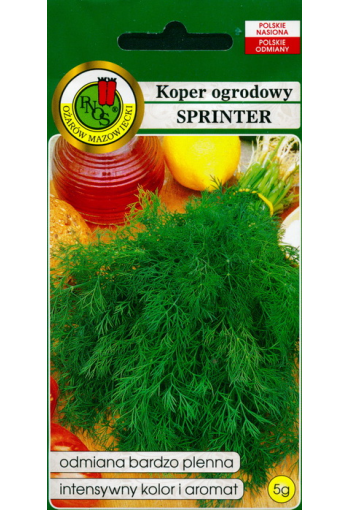Early maturing (30-35 days from germination to harvesting greens, 70-80 days from germination to harvesting with spices) variety.
Designed for growing for herbs and spices. The rosette is large, raised, 25-30 cm high. The leaves are green with large segments.
The greens are tender, juicy and highly aromatic.
Spicy fresh herbs are widely used in home cooking: in salads, appetizers, first and second courses, dried - as an aromatic seasoning. Umbrellas and seeds add a special dill aroma to vegetable and mushroom pickles and marinades. Sowing in the ground is carried out at the end of April - beginning of May. For continuous cutting of greenery, sowing is repeated every 10-14 days.
* Preparing dill seeds for sowing.
Before sowing, the seeds are soaked in a damp cloth for 2-3 days, then, after drying for 20 minutes, they are sown in wet furrows.
Other methods of preparing seeds are also practiced. For example, before sowing, they are soaked in water with the addition of urea (1/2 teaspoon of fertilizer per 1 liter). The seeds are kept in this solution for a day, then placed in a damp bag and kept for another 3 days. After this, slightly dry it to a loose state and begin sowing.
Good results are obtained by soaking dill seeds in a mushroom infusion. To do this, take 25 g of dried mushroom waste, crush it and add 200 g of water. A day later, filter the dill seeds and soak them in the infusion for 6 hours.
Preparing the site and sowing seeds in the ground.
Dill is a fairly cold-resistant plant. Its greatest requirement for heat is during the period of flowering and seed formation. It is very demanding of moisture, but its excess negatively affects the yield and essential oil content. It is advisable to place dill in lighted areas with cultivated soils rich in humus and filled with mineral fertilizers. High yields of greens are obtained on light, fertile soils.
Dill grows well when sown before winter. In spring, dill is sown very early, as soon as the snow melts. The dill bed is prepared in the fall. It is dug up to a depth of 20-25 cm, with the addition of 2-3 kg of humus, a tablespoon of ready-made garden mixture and a glass of wood ash per 1 square meter. m. In spring, the bed is leveled and grooves are made with a distance of 20 cm and a depth of 2-3 cm.
In the spring, dill seeds are either sown among other vegetables, or (approximately in the second half of April) sown separately in rows spaced at a distance of 25 cm. The seed sowing rate is 2 g/m2, the sowing pattern is 20x5 cm, the depth is 0.5 cm.
After sowing, the soil is compacted a little and carefully watered on top, sprinkled with a layer of 0.3 cm of sifted peat or humus. It’s a good idea to cover the bed with film before germination, lifting it 3-5 cm above the bed. With this method of sowing, dill produces friendly dark green shoots. To have fresh dill throughout the summer, you can sow it every 15 days from April to August.
Dill is also sown in the fall before winter, November 15-20, when the soil freezes, but the beds need to be prepared before frost. With this sowing, dill greens are obtained in the spring approximately 10-15 days earlier than with spring sowing.
Care, watering and fertilizing.
After the emergence of seedlings, the plants are thinned out, leaving a distance of 10 cm between them, and used for greens, and the remaining plants are grown for pickling and for seeds.
Water dill once a week at the rate of 5-18 litres per 1 square meter. m depending on the weather or 2 times a week, 6-7 litres per 1 sq. m. Dill can be fed with a solution of organic fertilizers. 0.5 litres of mullein are diluted in 10 litres of water, the solution is filtered and the plants are fed at the rate of 5 litrуs per 1 square meter. m.
Dill is an early ripening plant (the greens are ready 30-40 days after sowing).
Attention! With long daylight hours, plants bloom quite quickly. To shorten daylight hours, the bed is covered with opaque material. Dill grows and develops well when the daylight hours are 12 hours.
Harvesting.
Dill as a herb is harvested at a young age, when the stem and leaves are juicy and reach 15-25 cm in height (this is approximately 50-60 days after sowing). To use dill for marinades and canning, it is harvested after flowering, during the seed setting period (August-September). At this time, seeds and flower stems contain the maximum amount of essential oil.
Attention! Ripe seeds quickly fall off.
* Sweet sauce with parsley or dill.
Ingredients: 3 tbsp. l. vegetable oil, 1 tbsp. l. lemon juice, 1 tbsp. l. chopped parsley or dill, 1 tsp. honey.
1. Stir oil, lemon juice and honey.
2. Finely chop the greens and add to the sauce.
This “blitz” sauce is used immediately after preparation: for green salad or pasta.











